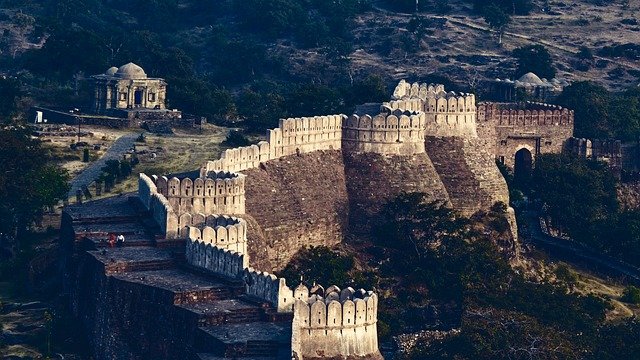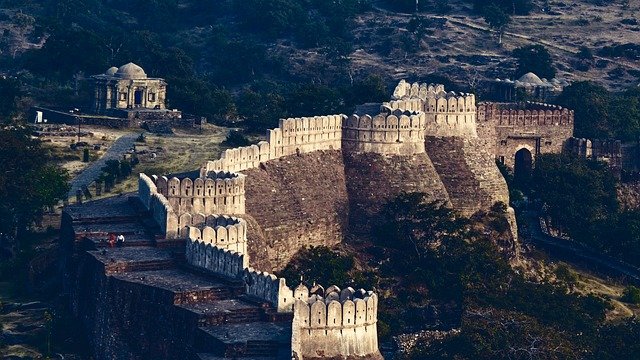Kumbhalgarh Fort Rajasthan’s rich history as we explore the captivating saga of Kumbhalgarh Fort. From its legendary origins and architectural marvels to the strategic vision of Rana Kumbha, delve into the timeless stories etched within the colossal walls. Join us in unraveling the cultural tapestry and historical significance that make Kumbhalgarh Fort an enduring icon of Rajasthan’s.

Table of Contents
Introduction : Kumbhalgarh Fort Rajasthan
Nestled amid the rugged landscapes of Rajasthan, Kumbhalgarh Fort stands as an immortal testament to the regal grandeur and valor that define this princely state. In this comprehensive exploration, we venture into the heart of Kumbhalgarh, where history intertwines with architectural brilliance, creating a narrative that transcends time.
Rising from Legend and Stone :
Kumbhalgarh’s genesis is shrouded in both myth and historical reality. The legendary tales and the 15th-century vision of Maharana Kumbha converge to create a fort that stands not just as a physical structure but as a living testament to Rajasthan’s cultural richness.

Architectural Grandeur:
Kisangarh Rajasthan : Switzerland of Rajasthan
The most striking feature of Kumbhalgarh is undoubtedly its colossal walls, stretching over 36 kilometers – a feat that places it second only to the Great Wall of China. As we delve into the intricacies of its layout, gates, and watchtowers, the architectural brilliance becomes apparent, showcasing the prowess of the builders.
Rana Kumbha’s Vision:
Rana Kumbha’s strategic vision positioned Kumbhalgarh as a fortress of unparalleled defense, playing a pivotal role in safeguarding the kingdom of Mewar. The fort, with its robust structure, stands not just as a symbol of military might but as a testament to the ruler’s foresight and commitment to the welfare of his people.
Unique Features:
Beyond its imposing walls, Kumbhalgarh boasts unique features that add to its allure. Badal Mahal, perched on a high peak, offers breathtaking panoramic views of the surrounding landscapes, while the Mammadev Temple, nestled within the fort complex, adds a spiritual touch to the military grandeur.
Kumbhalgarh in History:
Kumbhalgarh Fort, situated in Rajasthan, India, traces its roots to the 15th century, built by Maharana Kumbha. Steeped in legend, the fort’s colossal walls, extending over 36 kilometers, reflect its strategic significance in defending the Mewar kingdom.
Rana Kumbha’s visionary leadership played a crucial role in its construction, ensuring it stood as an impregnable bastion against invaders. Today, recognized as a UNESCO World Heritage Site, Kumbhalgarh Fort stands as a symbol of Rajasthan’s rich history, architectural brilliance, and the valor of those who defended its ramparts through the ages.
The fort has been a silent witness to a myriad of historical events and battles that shaped the destiny of Mewar. Its recognition as a UNESCO World Heritage Site underlines its global importance, preserving not only the physical structure but the echoes of the valorous past.
Visiting Today:
Accessible to modern-day explorers, Kumbhalgarh Fort opens its gates to enthusiasts and tourists alike. The fort, now a prominent tourism destination, invites visitors to traverse its corridors, providing a glimpse into the rich tapestry of history. The Light and Sound Show, a captivating initiative, narrates tales of heroism and sacrifice, creating an immersive experience for those eager to delve into the past.
Conclusion:
In concluding our odyssey through the monumental Kumbhalgarh Fort, we find ourselves immersed in a living chronicle of Rajasthan’s grandeur. The fort, with its towering walls and storied past, transcends being a mere historical relic – it is a testimony to the valor, cultural richness, and architectural brilliance that define this royal state. Kumbhalgarh Fort stands as a beacon, beckoning travelers and history enthusiasts to partake in its timeless narrative, ensuring that the legacy of Rajasthan’s heritage endures for generations to come.









